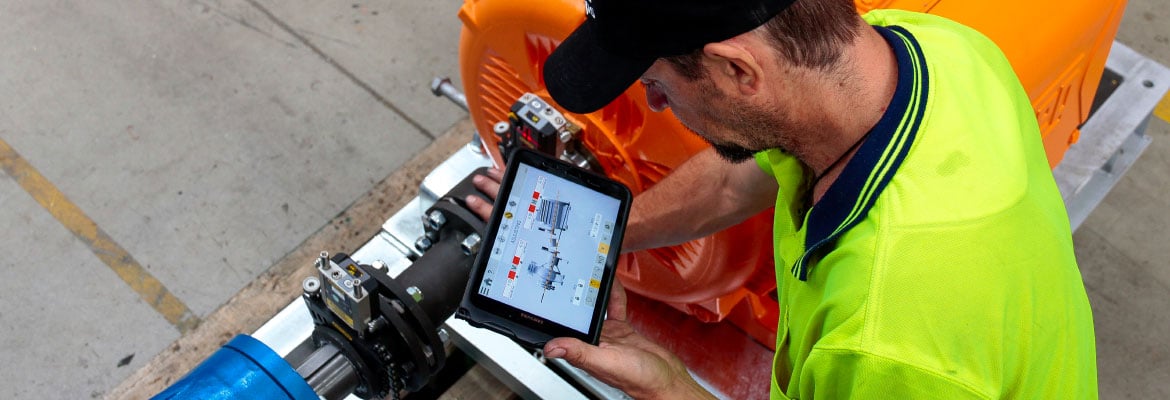Manufacturers allow for a certain tolerance of vibration in pumps. However, if you're noticing different vibrations or noises from your pump it is critical that an expert assesses the pumping system.
Global Pumps have long provided technical advice for pump operators. In this recent blog, our team share their top causes of vibration issues and how you can avoid them...

In this blog, our team share the six common causes of vibrations and how you can avoid these…
Pump cavitation
Pump cavitation occurs when there is insufficient net positive suction head - we discuss that in a recent blog. When the absolute pressure of the liquid at the impeller inlet, approaches the liquid vapor pressure, cavitation occurs causing pockets to form and collapse as they pass through the impeller.
Pump cavitation can be identified by the sound of the pump. Is it making a rumbling noise? Or distinctive popping? If so, your pump is cavitating.
To prevent cavitation, consider the following:
- Check the filters and strainers to ensure they are clean.
- Use a pressure gauge and flowmeter to reference the pump’s curve.
- Revaluate pump design if the pumped media path is not ideal.
Bent pump shaft
If your pump has a bent shaft, it can cause high axial phase vibrations. A dominant vibration generally takes place at 1X RPM if the bend is near the shaft centre, and it can occur at 2X RPM if it is bent near the coupling. A bent pump shaft is more commonly found at, or near, the coupling.
To check you do not have a bent shaft, use dial indicators.
Pump flow pulsation
This develops when a pump is operating near the shut-off head. Pressure gauges will show the pump’s discharge piping fluctuating. If your pump uses a discharge swing check valve, the counter-weight and valve arm will likely move to indicate the unstable flow.
Other causes of pump flow pulsation may include:
- Leaking valves
- Improper spring rates
- Multiple pumps on a common header
- Piping designs that restrict the flow
- Worn gland packing
Pump impeller imbalance
In some instances, a pump can seem as if it is misaligned, has insufficient bearings or is overheating, when in fact there is an imbalance in the pump assembly or another core component. This imbalance can also cause vibrations and heat build-up. It is critical that impellers are precision balanced, which has a huge impact on the life of the pump bearings.
If your pump’s impeller is imbalanced, the following risks apply:
- Shaft deflection - a bent shaft or uncontrolled resonance which results in deflection and damage to the entire pumping system
- Bearing failure
- Excessive vibration which damages the pump or system
- Failure of the mechanical seals or packing
- The pump begins to seize
Pump bearing issues
Bearing failure is one of the most common causes of pump vibration problems. This is generally caused by the fact that ball bearings are used long enough to experience the normal fatigue failure you would anticipate. These bearings can fail due to overload, excessive wear, weather, substances related to corrosion, failure of the lubricant, overheating or corrosion.
Issues can also result from poor bearing selection for the pump application. Manufacturers normally install the most suitable bearing for their pump.
Avoid bearing issues by regularly lubricating the bearings with oil mist, specialty oils or grease.
Misalignment
As some vibration is normal in pumps, it is critical that an expert assesses whether the vibration in a pump is due to misalignment between the pump shaft and the motor shaft. They will also be able to advise you whether it is severe enough to affect the pump’s overall performance and efficiency.
Misalignment is difficult to detect and measure externally. When your pump’s shaft is misaligned, the following could be caused:
- excessive axial or radial vibration
- high temperatures in the casing or near the bearings
- excessive oil leaks at the bearing seals
- loose coupling or foundation bolts
- excessive coupling failures
- breaking shafts near the coupling hubs or inboard bearings
Want to learn more about your pump’s vibration? Don’t leave it to chance, get in touch with Global Pumps' service team! We have a fully functional, world-class workshop, with the ability to talk directly to the technicians, you’ll get a clear understanding of your pump’s issue. Contact us today!

